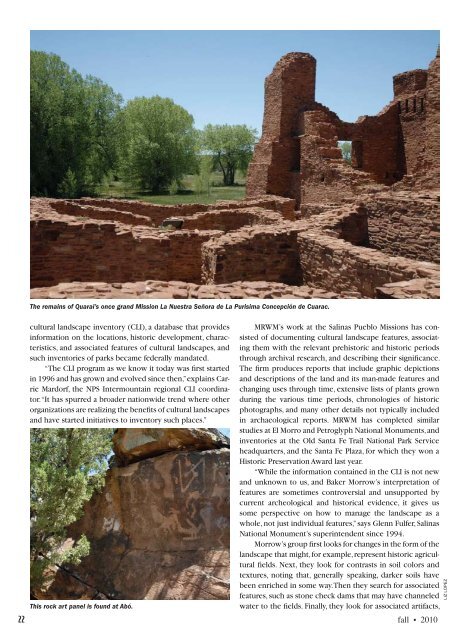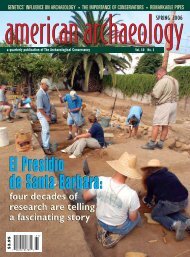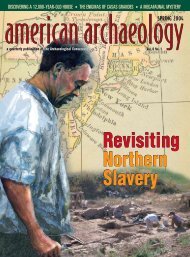Clovis Comet Debate - The Archaeological Conservancy
Clovis Comet Debate - The Archaeological Conservancy
Clovis Comet Debate - The Archaeological Conservancy
You also want an ePaper? Increase the reach of your titles
YUMPU automatically turns print PDFs into web optimized ePapers that Google loves.
<strong>The</strong> remains of Quarai’s once grand Mission La Nuestra Señora de La Purisima Concepción de Cuarac.<br />
cultural landscape inventory (CLI), a database that provides<br />
information on the locations, historic development, characteristics,<br />
and associated features of cultural landscapes, and<br />
such inventories of parks became federally mandated.<br />
“<strong>The</strong> CLI program as we know it today was first started<br />
in 1996 and has grown and evolved since then,” explains Carrie<br />
Mardorf, the NPS Intermountain regional CLI coordinator.<br />
“It has spurred a broader nationwide trend where other<br />
organizations are realizing the benefits of cultural landscapes<br />
and have started initiatives to inventory such places.”<br />
This rock art panel is found at Abó.<br />
MRWM’s work at the Salinas Pueblo Missions has consisted<br />
of documenting cultural landscape features, associating<br />
them with the relevant prehistoric and historic periods<br />
through archival research, and describing their significance.<br />
<strong>The</strong> firm produces reports that include graphic depictions<br />
and descriptions of the land and its man-made features and<br />
changing uses through time, extensive lists of plants grown<br />
during the various time periods, chronologies of historic<br />
photographs, and many other details not typically included<br />
in archaeological reports. MRWM has completed similar<br />
studies at El Morro and Petroglyph National Monuments, and<br />
inventories at the Old Santa Fe Trail National Park Service<br />
headquarters, and the Santa Fe Plaza, for which they won a<br />
Historic Preservation Award last year.<br />
“While the information contained in the CLI is not new<br />
and unknown to us, and Baker Morrow’s interpretation of<br />
features are sometimes controversial and unsupported by<br />
current archeological and historical evidence, it gives us<br />
some perspective on how to manage the landscape as a<br />
whole, not just individual features,” says Glenn Fulfer, Salinas<br />
National Monument’s superintendent since 1994.<br />
Morrow’s group first looks for changes in the form of the<br />
landscape that might, for example, represent historic agricultural<br />
fields. Next, they look for contrasts in soil colors and<br />
textures, noting that, generally speaking, darker soils have<br />
been enriched in some way. <strong>The</strong>n they search for associated<br />
features, such as stone check dams that may have channeled<br />
water to the fields. Finally, they look for associated artifacts,<br />
22 fall • 2010<br />
liz lopez




